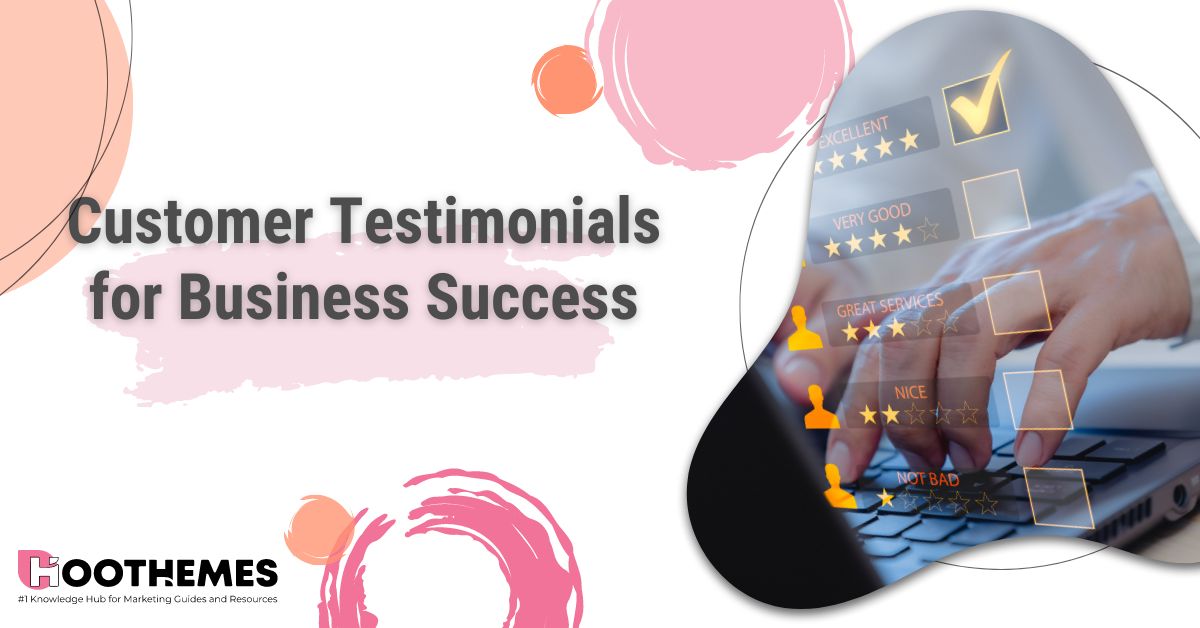In the realm of online shopping, customer testimonials play a pivotal role in building trust and credibility for your brand. One platform that has emerged as a powerhouse for sharing these testimonials is TikTok as well as Instagram.
User-created videos featuring product reviews on TikTok serve as robust social proof, demonstrating the quality and appeal of your product. These video reviews outshine traditional text-based reviews in terms of effectiveness and persuasiveness. They are not only more engaging but also more efficient in conveying the message.
Integrating TikTok product reviews into your website is a smart move. It positions your brand as modern and trendy, showing that you’re in tune with the latest trends. This strategy can lead to increased time spent on your site, reduced bounce rates, and improved search engine optimization (SEO), particularly for terms like Customer Testimonials.
TikTok influencers and users, especially those from Generation Z and the younger Millennial demographic, often discover new products through social media and product reviews, rather than relying on brand loyalty. When they find a product they love, they’re likely to share their positive experiences without any prompting.
There are numerous examples of TikTok reviews going viral and driving significant sales increases. The Bissell Little Green Machine and The Pink Stuff cleaning product are two such instances.
In essence, customer testimonials and product reviews on TikTok can be a powerful tool for building social proof, highlighting customer success stories, and boosting sales for your brand. By harnessing this user-generated content on your website, you can reap substantial benefits.
What are Customer Testimonials and Why Are They Important?
As online marketing emerges in every aspect of our lives, customer testimonials play a crucial role in establishing trust and increasing brand awareness. These are positive statements or reviews from satisfied customers about a company’s products or services.
Here’s why customer testimonials are so important:
- They build trust and credibility: Real customer testimonials demonstrate that a company’s products or services deliver on their promises. This helps eliminate doubts and makes it easier for potential customers to make a purchase.
- They influence purchasing decisions: Many customers, especially younger generations like Gen Z and Millennials, rely heavily on recommendations and reviews from others when making buying decisions. Positive testimonials can significantly influence these decisions.
- They improve SEO and website performance: Incorporating customer testimonials, particularly video testimonials from platforms like TikTok, can increase the time spent on a website, reduce bounce rates, and improve search engine optimization (SEO). This is particularly beneficial for terms like “TikTok” in your SEO strategy.
- They showcase customer success stories: Testimonials allow companies to highlight how their products or services have positively impacted real customers. This can be more persuasive than traditional marketing techniques.
Top Tools for Customer Testimonials
Customer testimonials are a powerful marketing tool. They leverage social proof to build trust, influence purchases, and showcase a company’s value proposition. Utilizing testimonials can provide significant benefits.
Here are some tools and services that can help you out in your journey:
#1 WatchThemLive
The winner of our list is WatchThemLive; one of the best CRO tools in the market. It goes without saying that videos have a more positive effect on your potential customers than plain text. Using this platform, you can preset your desired questions and your customers can record videos while answering them within a few clicks!
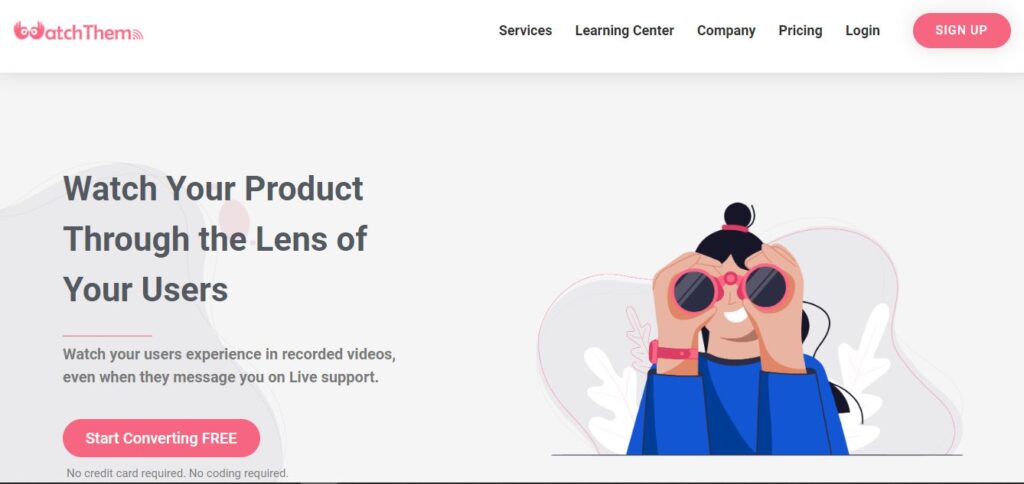
What really sets WatchThemLive apart from other tools is that not only does it provide you with tools to collect customer testimonials, but also it offers a full package for your website’s growth. Being one of the top user behavior analytic tools, it gives you the chance to track website visitors to see which parts of your web pages they pay more attention to and where they lose interest.
Features offered by this platform include session replay software, website heatmap tools, goal tracking, analytics dashboard, console recording, video testimonials, visual live chats, etc. You can easily leverage all these services to enhance your business performance and grow your brand awareness.
#2 Trustpilot
Trustpilot, a Danish consumer review platform, was established in 2007 with the aim of creating a universal symbol of trust between businesses and consumers. Here are some key points about Trustpilot:
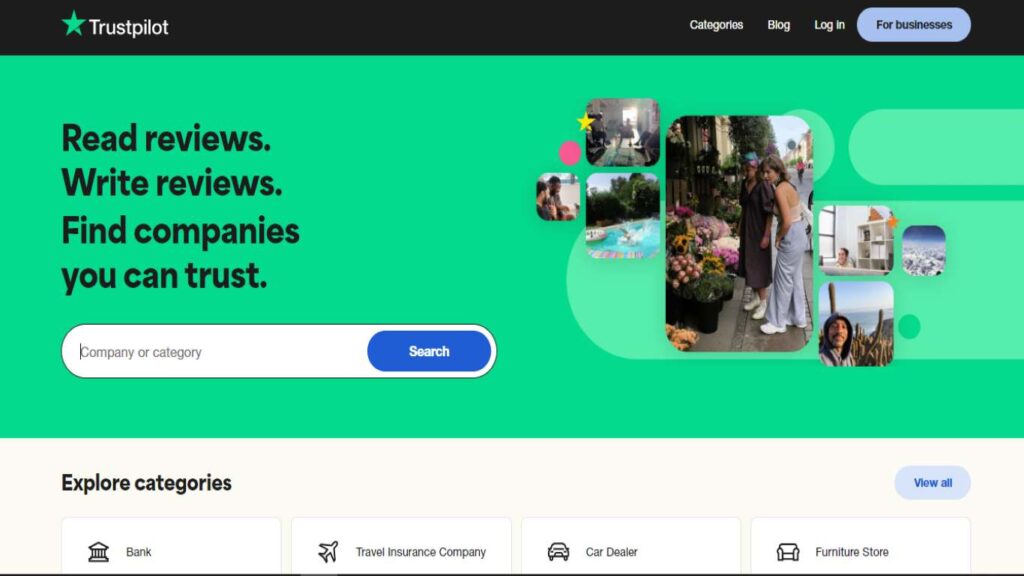
- Trustpilot is an independent digital platform where consumers can share their experiences and feedback about businesses, products, and services.
- The platform boasts over 238 million reviews across more than 980,000 websites and businesses. It receives nearly 1 million new reviews each month.
- Trustpilot’s goal is to foster trust and collaboration between consumers and businesses. Consumers can use the platform to research and make informed purchasing decisions, while businesses can gain insights to improve their offerings.
- Trustpilot is free for consumers, but businesses can claim their profiles and pay for additional features like advanced analytics and marketing tools.
- However, Trustpilot has faced some controversies, including allegations of fake reviews, businesses manipulating their ratings, and Trustpilot allowing companies to filter or hide negative reviews.
In summary, Trustpilot is a significant online review platform that aims to build trust between consumers and businesses. However, it has faced criticism regarding the legitimacy and transparency of the reviews on its site.
#3 Yelp
Yelp is a well-known online platform and mobile app that allows users to discover, review, and interact with local businesses and services. Here are some key points about Yelp:
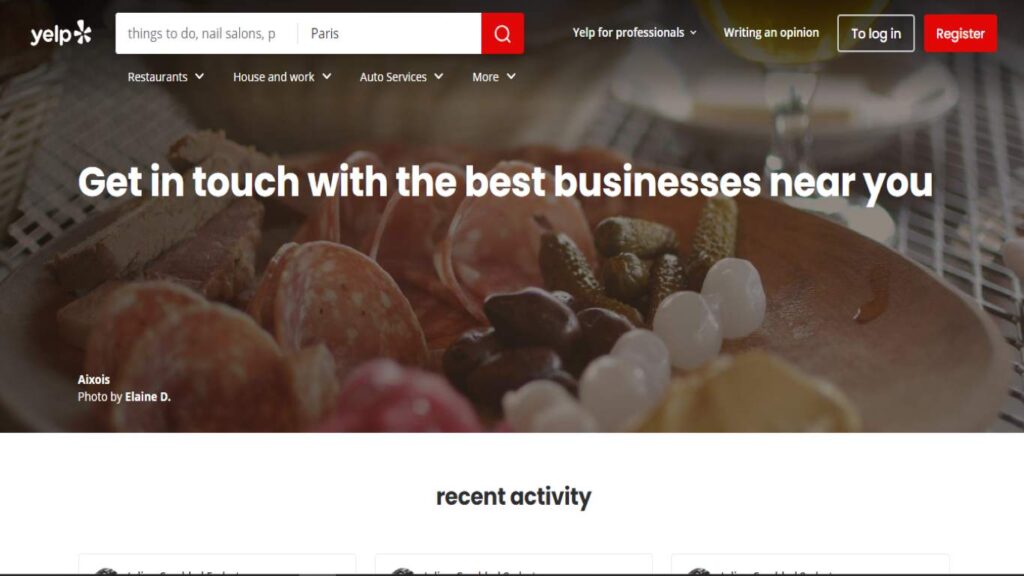
- Yelp was founded in 2004 and is headquartered in San Francisco. It is an American company that operates the Yelp.com website and mobile app.
- The Yelp platform hosts over 135 million crowd-sourced customer testimonials or reviews of businesses across a wide range of categories, including restaurants, shops, salons, doctors, and more.
- Users can search for local businesses, read reviews, view photos, make reservations, order food delivery, and even book appointments through the Yelp app and website.
- Yelp aims to help consumers discover and connect with great local businesses, while also providing businesses with tools to manage their online presence and reputation.
- The Yelp app is available for iOS, Android, and Apple Watch, allowing users to access Yelp’s features on the go.
- Yelp has faced some controversies around issues like fake reviews and businesses manipulating their ratings, but it remains one of the most popular and widely-used local business review platforms.
In summary, Yelp is a comprehensive platform that enables users to discover, evaluate, and interact with local businesses and services through crowd-sourced reviews and other features.
#4 Google Reviews
A platform for collecting and displaying customer reviews and testimonials, and it can also be integrated with Google Maps.
#5 Feefo
Feefo is an independent review and insights platform that helps businesses build better customer relationships, improve customer experience, enhance their brand reputation, and drive more sales. Here are some key points about Feefo:
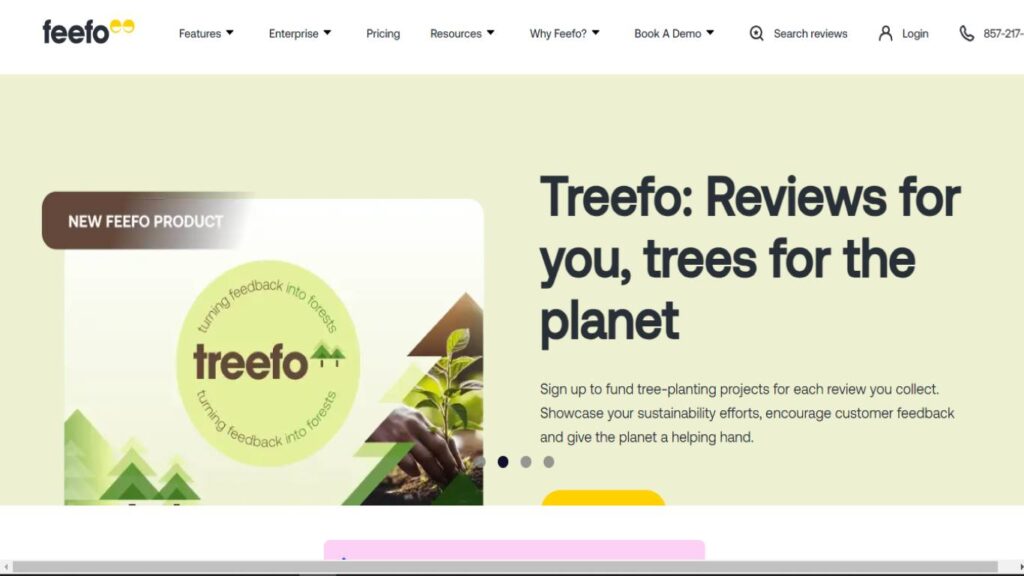
- Feefo is an invite-only platform that collects genuine, open, and honest testimonials or reviews from real customers. This ensures the reviews can be trusted.
- Feefo provides businesses with tools to display product and service reviews, which can increase customer confidence and boost sales.
- Feefo offers a range of features for businesses, including feedback request forms, reporting and analytics, customizable review widgets, and AI-powered insights.
- Feefo has a free plan as well as a premium plan with additional features like customizable feedback requests, photo/video reviews, and multichannel support.
- Feefo is used by over 3,500 global clients, incl
#6 SurveyMonkey
Here are the key points about SurveyMonkey:
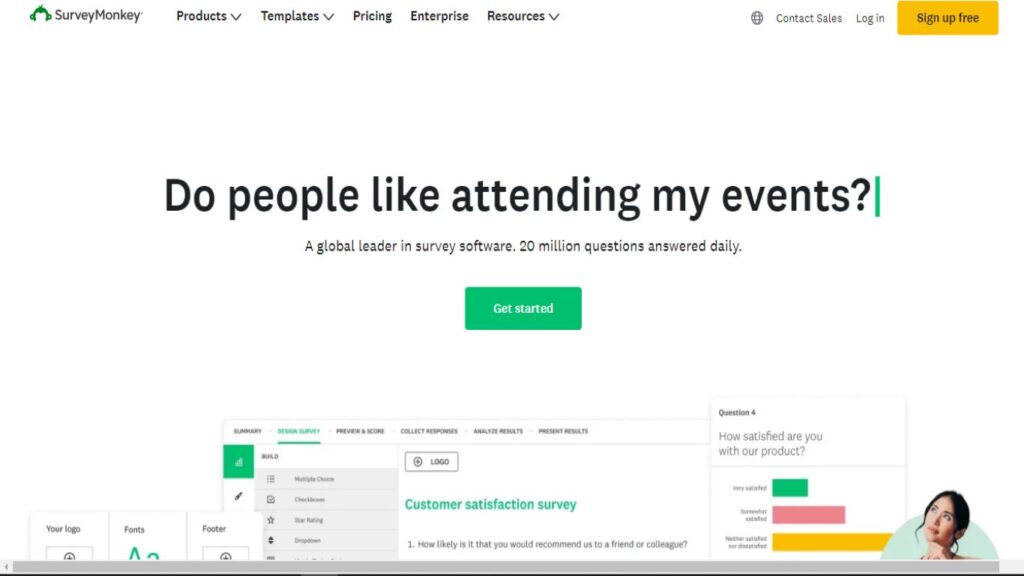
- SurveyMonkey is an experience management company that offers cloud-based software for brand insights, market insights, product experience, employee experience, and customer experience.
- The company was founded in 1999 by Ryan Finley and Chris Finley. In 2009, Spectrum Equity and Bain Capital acquired a majority interest in the company, and Dave Goldberg joined as CEO.
- SurveyMonkey went public on the NASDAQ exchange in 2018, launching at $12 per share and rising 43% on the first day of trading.
- Over the years, SurveyMonkey has acquired several other survey tools, including Precision Polling, Wufoo, Zoomerang, Fluidware, TechValidate, Usabilla, and GetFeedback.
- In 2021, SurveyMonkey announced a rebrand to Momentive, with the intent to better represent their business-to-business product suite. However, in 2023 the company rebranded back to SurveyMonkey after being acquired by an investor group.
- SurveyMonkey offers a range of features and tools for businesses to design and improve their products, services, and customer experiences, including survey templates, audience targeting, and analytics.
- The company has over 17 million active users worldwide and is considered a global leader in online surveys and forms.
In summary, SurveyMonkey is a prominent experience management platform that has grown through acquisitions and product expansions, and recently went through a brief rebrand to Momentive before reverting back to the SurveyMonkey name.
#7 Qualtrics
Qualtrics is an American experience management company founded in 2002 and headquartered in Seattle, Washington, and Provo, Utah.
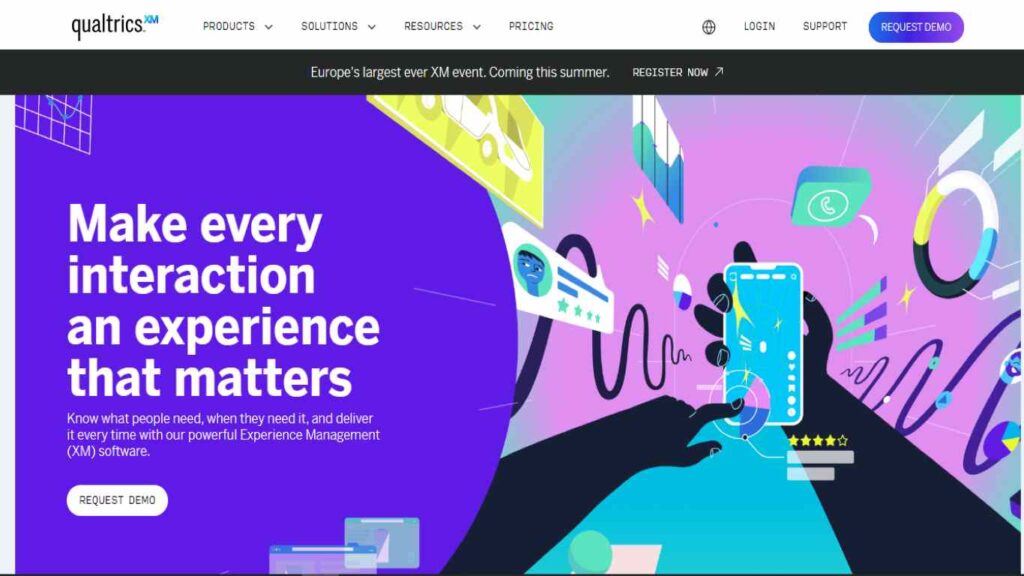
Key facts about Qualtrics:
- Qualtrics provides an experience management platform that helps businesses design and improve products, services, and customer experiences.
- The company was acquired by SAP in 2018 for $8 billion, which was SAP’s second-largest acquisition at the time.
- Qualtrics went public in 2020 after being acquired by SAP, and in 2023 the workforce was reduced by 15% after the acquisition.
- Qualtrics focuses on diversity, equity, and inclusion (DEI) initiatives, including employee resource groups and bias training.
- The company hosts an annual experience management summit called Qualtrics X4, which was held virtually in 2021 and 2022 due to the pandemic.
- Qualtrics has been recognized as a leader in various industry analyst reports and rankings for its experience management platform and capabilities.
- The company has made several strategic acquisitions over the years, including Statwing, Delighted, and Clarabridge, to expand its offerings.
In summary, Qualtrics is a prominent experience management platform provider that was acquired by SAP and has continued to grow and innovate in the experience management space.
#8 UserTesting
UserTesting is a platform that allows users to share their testimonials, perspectives and feedback on various products, services, and digital experiences. Here are the key points about UserTesting:
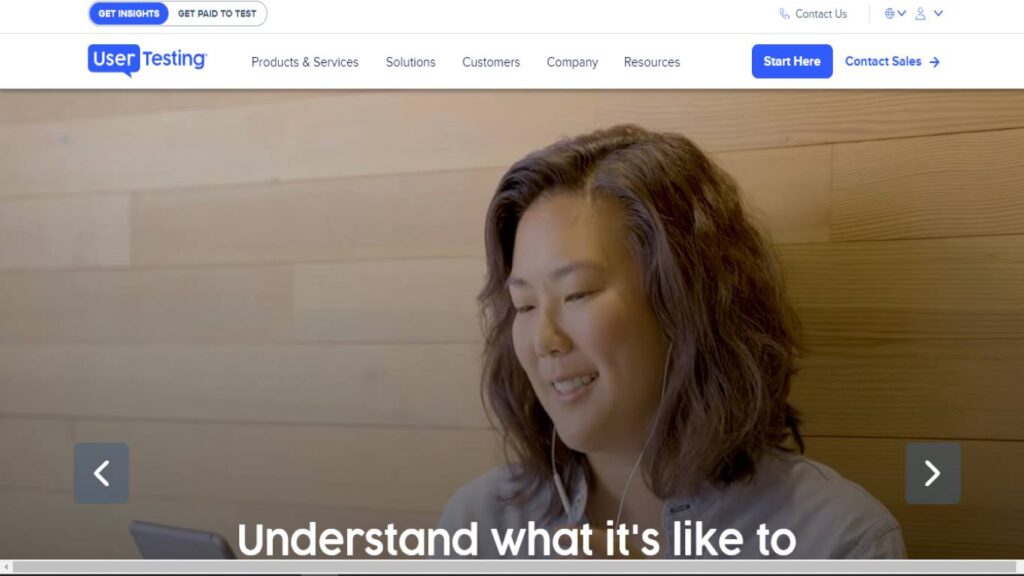
- UserTesting is a platform where users can participate in tests and share their thoughts and experiences with companies, helping them improve their offerings.
- Users can earn money by completing these tests, which involve tasks like navigating websites, using mobile apps, or providing feedback on user interfaces.
- The platform aims to provide businesses with valuable, real-time insights from actual users to help them enhance their products, services, and customer experiences.
- UserTesting recruits target users to complete tests, which can be done remotely and are often completed in a matter of hours rather than weeks.
- The platform is used by many leading brands to gather customer feedback and empathize with their users, which helps drive innovation and better decision-making.
- UserTesting provides a range of features and tools for businesses to collect, analyze, and act on the user insights gathered through the platform.
In summary, UserTesting is a user research platform that connects businesses with real users to gather valuable feedback and insights that can be used to improve products, services, and customer experiences.
#9 Klue
Klue is an AI-powered Competitive Enablement platform designed to help product marketers and other teams collect, curate, and deliver actionable competitive intelligence. Here are the key points about Klue:
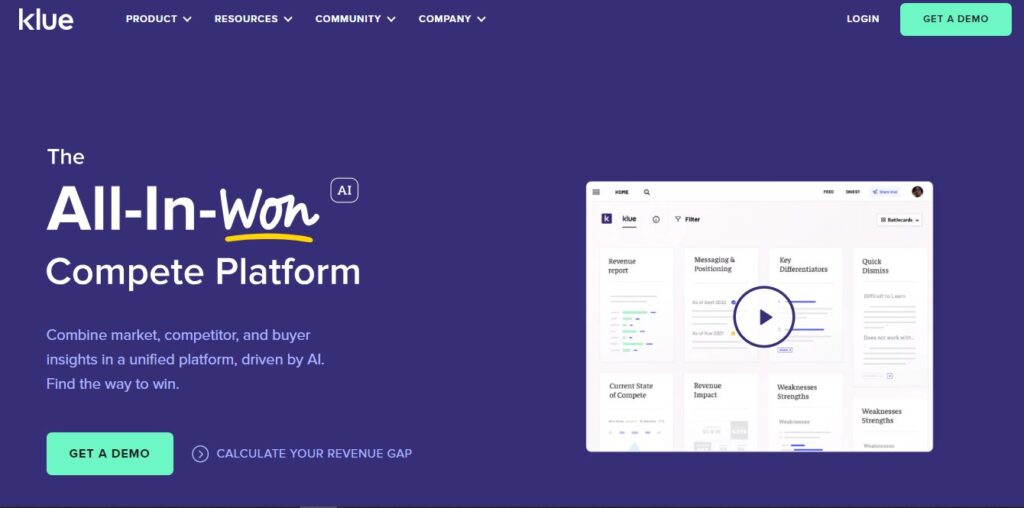
- Klue is a platform that enables businesses to gather market, competitor, and buyer insights in a unified system driven by AI.
- It helps product marketers, sales, customer success, and executive teams stay up-to-date on competitive threats and arm them with the intelligence they need to make better decisions and win more deals.
- Klue collects data from millions of sources, both external and internal (like Salesforce, Slack, emails), and uses AI to surface the most relevant competitive insights.
- The platform organizes this intelligence into easy-to-use battlecards, newsletters, and other formats that can be shared across the organization. This ensures teams are never blindsided by competitors.
- Klue aims to help businesses improve their go-to-market strategies, strengthen their positioning, and measure the impact of their competitive programs.
- The platform is used by over 3,500 global clients, including major brands like Dell, Adobe, and Community Brands.
In summary, Klue is a comprehensive competitive intelligence platform that empowers businesses to collect, curate, and deliver actionable insights to drive better decision-making and win more deals.
#10 GetApp
A platform that allows businesses to collect customer reviews and testimonials for software and applications.
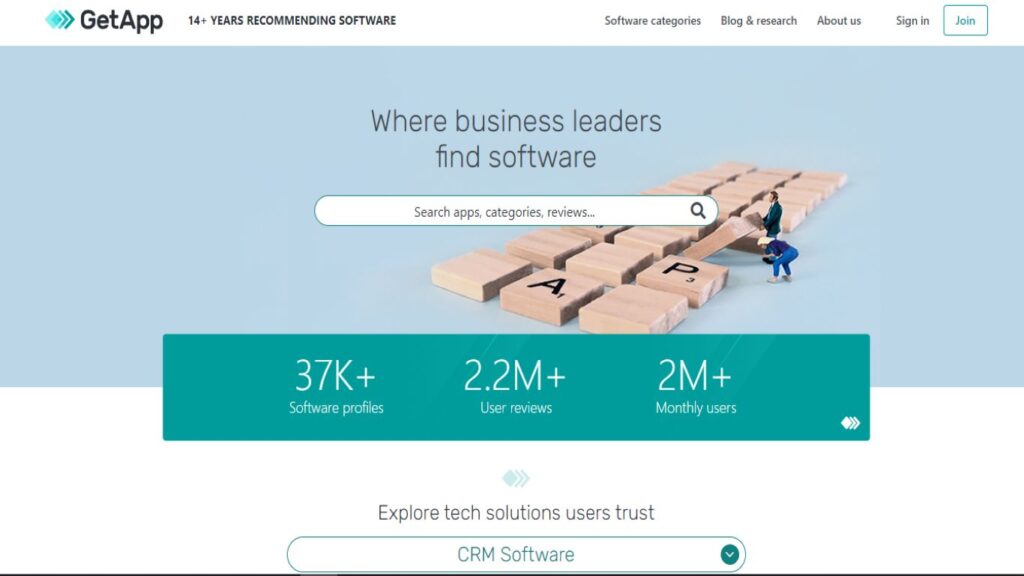
#11 TrustRadius
TrustRadius is an online platform that allows users to find and review top-rated software and services. Here are some key points about TrustRadius:
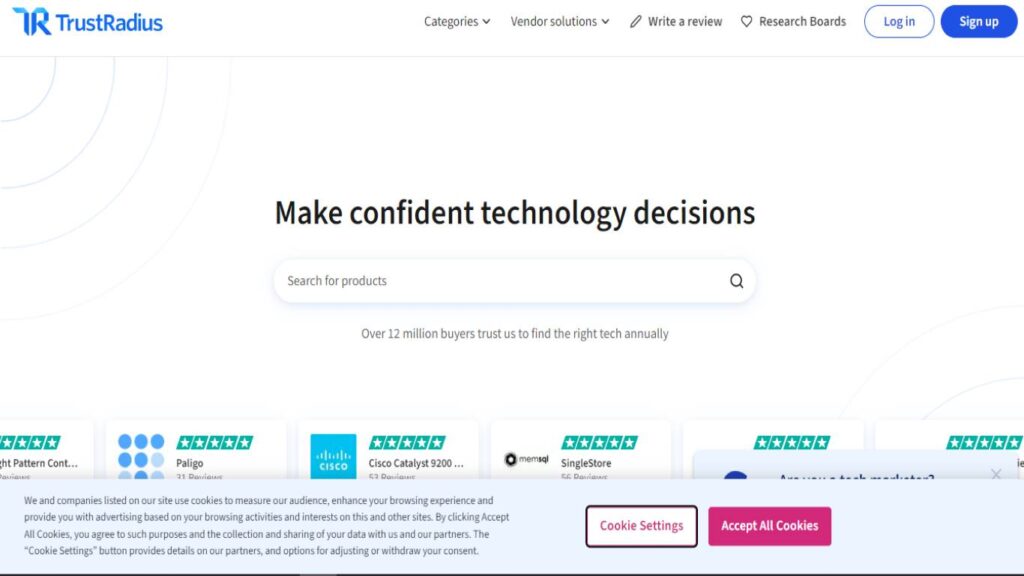
- TrustRadius is a platform that hosts in-depth reviews and ratings of over 400 different software categories, including PaaS, NoSQL, BI, HR, and more.
- The reviews on TrustRadius are written by verified users, providing real-world insights and helping buyers make informed purchasing decisions.
- TrustRadius is considered one of the best platforms to find user reviews and gain valuable information about various business software and services.
- The platform aims to help users find the top-rated software and services based on the detailed reviews and ratings from other verified users.
In summary, TrustRadius is an independent review platform that provides a trusted source of information to help users research and evaluate different business software and services based on real user experiences and insights.
Video Testimonial Platforms
There are several platforms that can be used to gather video testimonials from users, including:
#1 WatchThemLive
WatchThemLive, as mentioned earlier, is considered one of the best web analytics tools that offer video testimonial services as well. In fact, all you need to do is come up with a set of questions you’d like your customers to answer.
Then, WatchThemLive will take over everything and collect customer feedback hassle-free. This way, you no longer have to spend hours on getting your customers to leave feedback on your products/services. WatchThemLive will accurately get user feedback on your website.
#2 Wistia
A video hosting platform that allows businesses to collect and manage customer testimonials.
#3 Customer.io
A marketing automation platform that includes a feature for collecting customer testimonials.
#4 Tint
A social media aggregator that allows businesses to gather and display customer testimonials from various social media platforms.
#5 Yotpo
A customer review and user-generated content platform that includes a feature for collecting video testimonials.
#6 Promo
A video creation platform that allows businesses to easily create and collect customer testimonials.
#7 Testimonial Hero
A platform that allows businesses to collect, manage, and display customer testimonials in various formats, including video.
How to Use User Testimonials
Now that we have the testimonials, let’s find out some of the best hacks on where and how to use these user testimonials:
Use Customer Testimonials Prominently on Your Website
Display them prominently on your homepage, product pages, and landing pages to build trust and credibility with potential customers.
Include Social Proof
Include the customer’s name, company, and a headshot to add credibility and make the testimonial more relatable.
Use Video Testimonials
Video testimonials can be more powerful than written ones because they allow customers to see and hear the enthusiasm and sincerity in the person’s voice.
Use Customer Testimonials in Email Marketing
Incorporating customer testimonials in your email marketing campaigns can help increase click-through rates and conversions.
Use Customer Testimonials in Ads
Use customer testimonials in your online and offline advertising to help boost the effectiveness of your campaigns.
Utilize Customer Reviews
Encourage customers to leave reviews on sites like Google, Yelp, and TripAdvisor, and then feature those reviews prominently on your website.
Allow Customers to Submit Their Own Testimonials
Create an easy process for customers to submit their own testimonials, and then feature them prominently on your website.
Use Customer Testimonials in Your Sales Process
Use customer testimonials to help overcome objections and build trust with potential customers during the sales process.
How to Ask for Customer Testimonials
Here are a few best practices for asking for customer testimonials:
- Make it easy: Keep the process of leaving a testimonial as simple as possible, providing a link to a dedicated testimonial form or survey.
- Timing is everything: Ask for testimonials at the right time, such as immediately after a customer has had a positive experience with your product or service.
- Show appreciation: Show appreciation for the time and effort of your customers for providing a testimonial, for example by offering a discount or a small gift.
- Use a clear call-to-action: Use a clear call-to-action in your request for testimonials, such as “Please share your experience with us” or “We would appreciate your feedback”
- Use the right channel: Choose the right channel for the request, for example, email, social media, or in-person.
- Keep it personal: Personalize the request, for example by addressing the customer by name and reference their previous interaction with your business.
- Follow up: Follow up with customers who have not provided a testimonial, but don’t be pushy or aggressive, a friendly reminder is enough.
Integrate Customer Testimonials on Your Website
Using customer testimonials on your website can be a powerful way to build trust and credibility with potential customers. Here are a few best practices for using customer testimonials on your website:
- Use them prominently: Display testimonials in a prominent location on your website, such as the homepage or product pages.
- Use images and videos: Use images and videos of the customer providing the testimonial, to make it more engaging and credible.
- Use real names and photos: Include the customer’s real name and photo, so potential customers can see that the testimonial is from a real person.
- Use quotes: Use quotes from the testimonials in your website’s copy, to help build credibility and trust.
- Categorize them: Group testimonials by product, service, or industry to make it easy for website visitors to find the most relevant testimonials.
- Use them on landing pages: Use testimonials on landing pages for specific products, services or campaigns to increase the conversion rate.
- Use them on social media: Share testimonials on social media platforms, it can help you to increase brand awareness and credibility.
- Use them in email marketing: Incorporate testimonials into your email marketing campaigns, it can help you to build trust and credibility with your subscribers.
Customer Testimonials’ Use in Marketing Materials
Here are a few best practices for using customer testimonials in your marketing materials:
- Use them in brochures and flyers: Include customer testimonials in brochures and flyers to provide social proof and credibility for your products or services.
- Use them in presentations: Use customer testimonials in presentations to build trust and credibility with potential customers.
- Use them in email marketing: Include customer testimonials in email marketing campaigns to build trust and credibility with subscribers.
- Use them in social media: Share customer testimonials on social media platforms to build trust and credibility with potential customers.
- Use them in videos: Create videos that feature customer testimonials to provide a more engaging and personal way to showcase the benefits of your products or services.
- Use them in case studies: Feature customer testimonials in case studies to provide real-world examples of how your products or services have helped other businesses.
- Use them in advertising: Use customer testimonials in advertising campaigns, it can help you to build trust and credibility with potential customers.
- Use them in press releases: Use customer testimonials in press releases to provide third-party validation for your products or services.
How to Ensure Customer Testimonials Are Genuine and Not Fake
To ensure that customer testimonials are genuine, you should verify their authenticity by reaching out to the customer and asking for their permission to use their testimonials.
You can also check the customer’s social media profiles and online activity to verify their identity. Additionally, you can also use third-party review platforms like Trustpilot, Yelp, etc.
FTC Guidelines for Using Customer Testimonials in Advertising
To follow FTC guidelines for using customer testimonials in advertising, you should disclose any material connections between the business and the customer providing the testimonial, clearly and prominently display any disclosures, and not make any false or misleading claims in the testimonial.
The Use of Customer Testimonials to Build Trust and Credibility With Potential Customers
To use customer testimonials to build trust and credibility with potential customers, you should select testimonials that highlight the benefits and results that customers have experienced, and present them in a clear and credible format.
You can also use customer testimonials on your website, social media, and in your marketing materials to build trust and credibility with potential customers.
Customer Testimonials to Drive Sales and Increase Conversions
To use customer testimonials to drive sales and increase conversions, you should use them in key areas of your website, such as the homepage, product pages, and landing pages, and also include them in your email marketing campaigns and other marketing materials.
Additionally, you can use customer testimonials to create social proof, which is the idea that people will be more likely to purchase your product or service if they see that other people have had positive experiences with it.
Conclusion
In summary, customer testimonials, especially those in video format from platforms like TikTok, are vital for establishing trust and credibility in today’s digital market. By integrating diverse tools such as Trustpilot and Yelp, businesses can gather and showcase authentic feedback effectively.
Implementing best practices ensures credibility and boosts conversions. Leveraging these testimonials strategically can drive sales and foster lasting trust with customers, making them an essential asset for business success in the digital age.
FAQs
Q1. How Do I Choose Which Customer Testimonials to Use?
Choosing which customer testimonials to use can be important, as they can have a big impact on how potential customers perceive your business. Here are a few best practices for choosing which customer testimonials to use:
1. Look for specific and detailed feedback: Testimonials that are specific and detailed are often more credible and convincing than general statements.
2. Choose a variety of customers: Use testimonials from a variety of customers, including different industries, demographics and customers that have used different products or services.
3. Look for positive but realistic feedback: Choose testimonials that provide a balanced and realistic view of your products or services, rather than overly positive or unrealistic feedback.
4. Check for grammar and spelling: Make sure that the testimonials are well-written and free of grammatical and spelling errors.
5. Use recent testimonials: Use recent testimonials that reflect your current products, services, and processes.
6. Consider the medium: Testimonials can be in different mediums such as text, video or audio, consider which medium will be the most effective for your audience and campaign.
7. Look for testimonials that address pain points: Use testimonials that address specific pain points or problems that your potential customers may have, and how your products or services can solve them.
Q2. How Can I Use Customer Testimonials to Improve My Product/Service?
#1 Use them for product development: Use customer testimonials to identify areas where your product or service can be improved and to inform product development decisions.
#2 Use them for customer service: Use customer testimonials to identify areas where your customer service can be improved and to inform customer service decisions.
#3 Use them for marketing: Use customer testimonials to identify areas where your marketing can be improved and to inform marketing decisions.
#4 Use them for training: Use customer testimonials to train your employees on how to better serve your customers and improve their experience.
#5 Use them for continuous improvement: Use customer testimonials to continuously improve your product or service over time.
#6 Use them for understanding customer’s needs: Use customer testimonials to understand your customer’s needs, wants, and pain points and use it to create new products or services.
#7 Use them for measuring success: Use customer testimonials to measure the success of your product or service and to identify areas where it can be improved.
By using customer testimonials to improve your product or service, you can gain valuable insights and make informed decisions that will help you to better serve your customers and increase their satisfaction.
